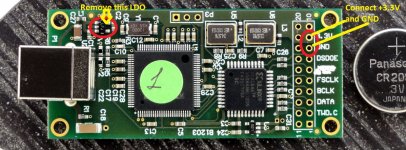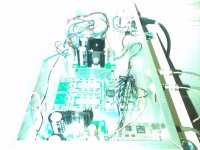Did you have the 3.3 v?
I take it from the Amanero.
I take it from the Amanero.
An externally hosted image should be here but it was not working when we last tested it.
Did you have the 3.3 v?
I take it from the Amanero.
Yes, I have tried 3.3v direct from Amanero and dedicated 3.3v voltage regulator.
I'm going to try shorter, 75 to 100mm, CAT5 solid core twisted pairs. Just have to build them. The headers are a pain to find, but I might have a local source.
thanks,
Vince
The issue that you described with the sound playing in high speed in Windows tells me that you probably have a software (Windows) issue. It happens to me sometimes, if I overdo it with hot-plugging the Amanero from the PC's USB port. Sometimes it has taken a Windows reboot to solve the problem.
What software setup are you using in Windows? Are you sure that things are working OK? Do you have a scope to check that the Amanero's I2S lines are indeed outputting a signal?
I had used an Amanero with my Soekris for months with no problem.
What software setup are you using in Windows? Are you sure that things are working OK? Do you have a scope to check that the Amanero's I2S lines are indeed outputting a signal?
I had used an Amanero with my Soekris for months with no problem.
I don't think it's my software. Dies the same on Linux and Windows. Last night it looked like it wanted to lock, sort of stuttering, but never catching on.
I installed 3 inch twisted pairs and got no lock today. Getting a smaller transformer tomorrow. Will try it too. Getting a diyinhk adapter in a few weeks. Will try it and see if there's any difference.
Have a scope, but not sure how to use it. Just connect to ground and signal and see if anything appears on the scope?
I installed 3 inch twisted pairs and got no lock today. Getting a smaller transformer tomorrow. Will try it too. Getting a diyinhk adapter in a few weeks. Will try it and see if there's any difference.
Have a scope, but not sure how to use it. Just connect to ground and signal and see if anything appears on the scope?
I measured a few of the twisted pairs and they read 1.1uF. I don't how accurate the reading is, but I have measured know values and the meter checks out.
I read that for high frequency signals like in I2S signals, the wire should be under 400 pF.
How does one keep the capacitance low besides short lengths?
I read that for high frequency signals like in I2S signals, the wire should be under 400 pF.
How does one keep the capacitance low besides short lengths?
Maybe try reflashing the Amanero with the latest firmware.
Amanero Technologies
Sometimes I find this helps.
Just follow the instructions that come with the firmware tool.
use the default settings & don't change anything
CPLD_for_1080 &
firmware_1096c3w2
Amanero Technologies
Sometimes I find this helps.
Just follow the instructions that come with the firmware tool.
use the default settings & don't change anything
CPLD_for_1080 &
firmware_1096c3w2
I measured a few of the twisted pairs and they read 1.1uF. I don't how accurate the reading is, but I have measured know values and the meter checks out.
I read that for high frequency signals like in I2S signals, the wire should be under 400 pF.
How does one keep the capacitance low besides short lengths?
No way 1.1uF is accurate. It's a bunch of orders of magnitude off. I wouldn't worry about cable capacitance with short thin wires.
I had my Soekris fed from an Amanero that was literally hanging by a bunch of not-too-short UTP pairs for months with no problems. I believe the Amanero's FW was an old one, at least a couple of years back.

I flashed the board before going to work.
Need to wire it up again before trying it.
Hoping this works.
Need to wire it up again before trying it.
Hoping this works.
Went home for "lunch", walked the dog and quickly hooked up the I2S to the dam1021 with the 6 inch (150mm). Got lock on Win and Linux OS! The road did the trick.
It's sounds a little rough from a cold start, but I can hear the potential. Amp needs warm up for an hour too.
Thanks for all the tips, especially the flashing, which is real easy.
I can't seem to get a good pic with my tablet, but here's one anyway.
Now have to get in the car and drive back to work.
Thank!
Vince
It's sounds a little rough from a cold start, but I can hear the potential. Amp needs warm up for an hour too.
Thanks for all the tips, especially the flashing, which is real easy.
I can't seem to get a good pic with my tablet, but here's one anyway.
Now have to get in the car and drive back to work.

Thank!
Vince
Attachments
Good to hear. I use the Amanero in a DAC I manufacture & recently have a few that were having trouble connecting. Reflashing the firmware always seem to work. The oem tool 117 is quite old as Dimdim pointed out yet it fixes the problem. I automatically reflash all my boards now before installing them & have had no more issues.
Does the amanero work with the iPhone?
Yes, but the volume control does not
external 3.3V supply
Is this the correct way to power the Amanero with an external 3.3V psu?
Remove the LDO at U2 (marked LFJ) and connect GND and +3.3V to the pins 8 and 9 respectively?

Is this the correct way to power the Amanero with an external 3.3V psu?
Remove the LDO at U2 (marked LFJ) and connect GND and +3.3V to the pins 8 and 9 respectively?

An externally hosted image should be here but it was not working when we last tested it.
Last edited:
Okay, I got the answer from the man himself, Domenico.
Just remove the resistor at L1 and connect the power as in the picture above.
I did exactly that and it works 🙂
Just remove the resistor at L1 and connect the power as in the picture above.
I did exactly that and it works 🙂
I will be grateful if someone share his experience with i2c output of the board: I'm using I2c to control PCM1975 and I noticed that only working firmware /PLD version is 1080. On all other firmware revisions i2c output is not working correctly. Any suggestions please?
Does anyone know how to pipe an SACD as DSD through Jriver to the Amanero without it being converted to PCM first ?
cheers
david
cheers
david
Try turning bitstreaming to DSD on
Output encoding to none & select the asio driver for the Amanero.
Output encoding to none & select the asio driver for the Amanero.
- Home
- Vendor's Bazaar
- USB to I2S 384Khz - DSD Converter
